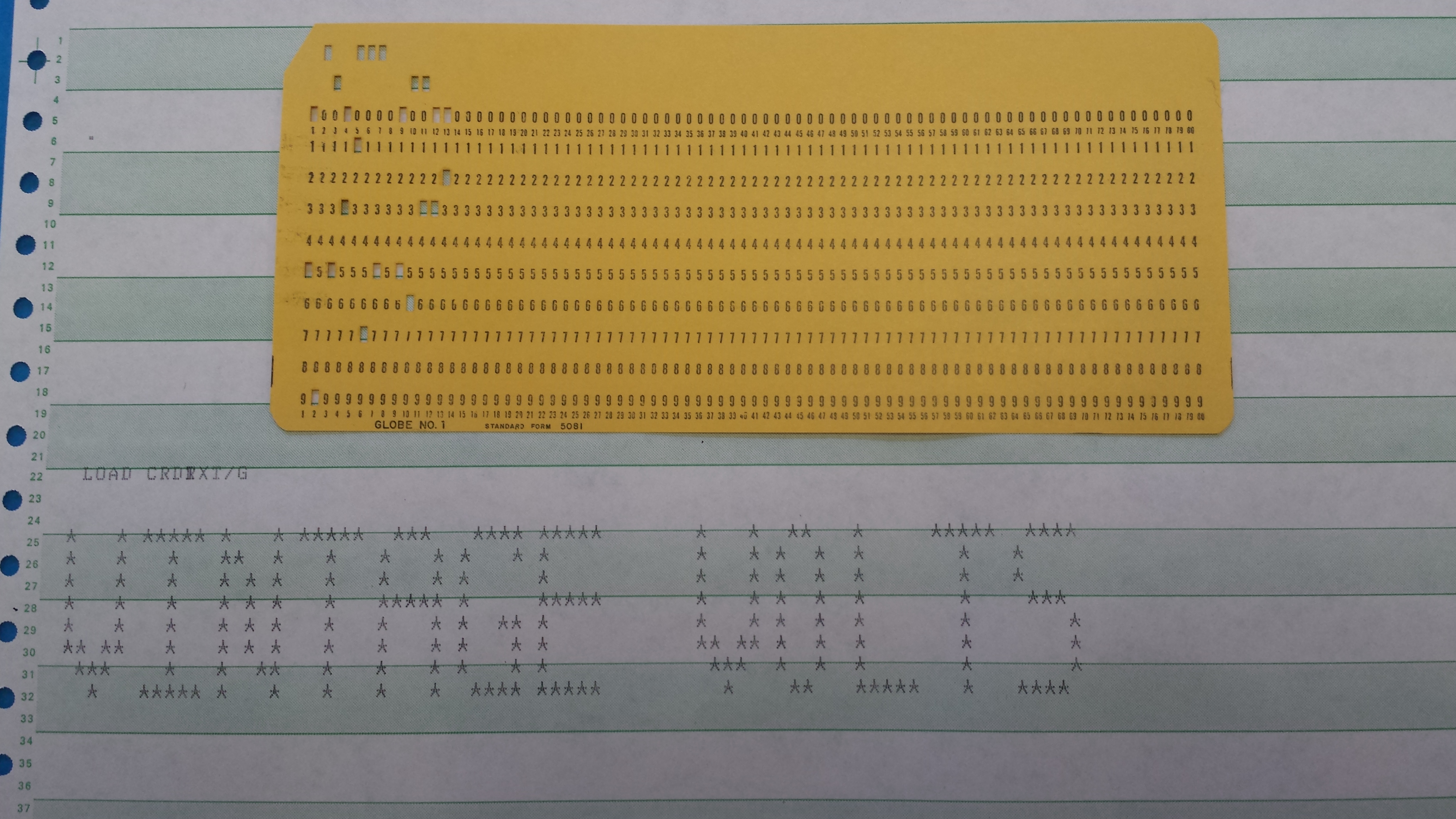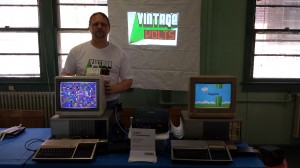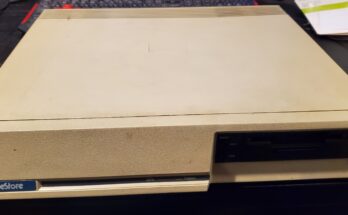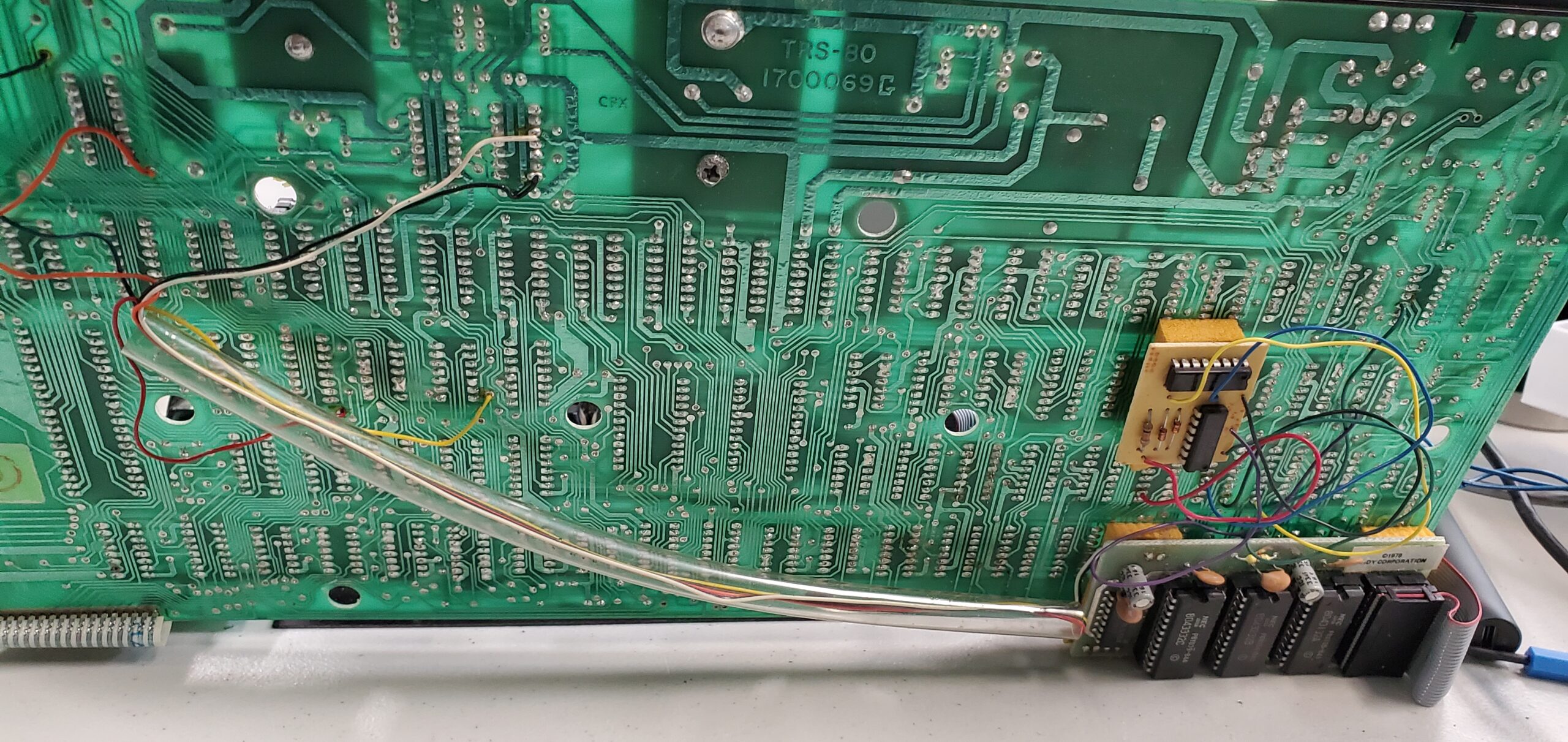In 2014, I was invited to attend the Vintage Computer Festival (VCF) East 9.1 as an exhibitor. I had recently finished cleaning and assembling a Texas Instruments TI-99/4A computer with a Peripheral Expansion Box (PEB), so that became my exhibit. It was going to be the first VCF I ever attended, and I’m glad I did. It was a wonderful experience!
I arrived at the InfoAge Science Center at 7:30 on Friday night, just in time to unload my equipment and get a feel for the layout of the show. Afterwards, I checked into my hotel and went to Yestercades in Red Bank, NJ, a subject of a future Vintage Volts article.
Meanwhile, here are observations of the show from my personal point of view.
My “span of interest” in computer systems stems mainly from the trifecta days of the Commodore PET, Apple II, and TRS-80. Anything beyond the scope of those kind of computer systems, called “home computers”, had little influence on my curiosity. That’s what made the VCF so interesting for me. I actually had an opportunity to learn something new.
Since I didn’t attend the many morning lectures on Saturday and Sunday, I was free to explore some of the other exhibits without having to man my own. The public attendees were released to the exhibits at 2PM each day. I knew I had time to explore.
Saturday morning, I decided to skip the lectures. I didn’t want to wake up at zero-dark-30 hours (military time) and be at InfoAge before 8AM. I arrived at 10AM with plenty of time to set up both TI-99/4A computer systems. My kids were with me, so I had a little extra help. Eventually, I had things placed where I liked them, along with hiding the cables and boxes (per show policy).
Next, I ran a couple of rubbermaid containers of Commodore software and books to take to the Consignment Room. Exhibitors were allowed some space to put their wares which were to be sold, but could only be sold in that room. You were not allowed to sell stuff at your table. This served two purposes: 1) the show didn’t turn into a “flea market”, and 2) it allows the venue to earn some residual income to be able to run these shows. The venue received 15% of the sales.
Now, I had a chance to see some of the other exhibits before lunch, and before the general public is allowed in at 2PM. Granted, when 2PM arrived, I had to man my booth, so I couldn’t freely visit any exhibit I wanted to. But, my kids knew enough of my setup to answer some basic questions for visitors, or text me to return if needed.
Here are some of the exhibits I discovered:
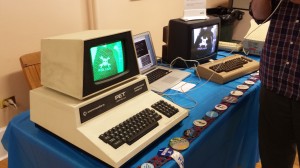
A project I dub “Raspberry PET”
The gentleman who presented this exhibit created custom software for a Raspberry Pi which took the live moving image from a smartphone camera, processed it, and created ASCII Art which was presented on a Commodore PET and C64 in real time. From my understanding, it required the use of some custom code and a User Port interface on the PET to receive data from the Raspberry Pi… and it was a whole lot faster than that old ASCII art we used to receive at 2400 baud.
Newsroom
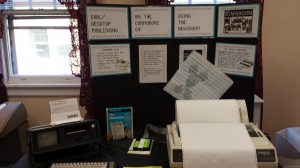
I thought this exhibit was rather unique. I would have never thought about ever putting up an exhibit like this, but it has some genius thinking to it. It’s almost diorama-like in its style. You have to keep in mind that there were attendees who were not alive during the days represented in the Newsroom exhibit.
This shows the program “Newsroom”, by Springboard Software, as it is used on the Commodore 64 platform. Or in this case, the portable SX-64. While people take for granted our ability to do impressive desktop publishing tasks at home today, back then, there was little in the way of affordable home desktop publishing. This exhibit captures that moment in time in the mid-1980s.
I actually bought Newsroom for myself in the mid-1980’s. I used it on occasion to write newsletters for my Army unit(s) where I was stationed. I also had a passing interest in creating better looking printed materials than what could be done in Broderbund’s “The Print Shop.”
Electronic Games
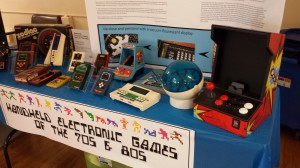
These may not look like vintage computers, but technically, they are. Almost all of them, that is (can you guess which one isn’t?) They have computing systems in them that act on preprogrammed responses to your input. Their computing power isn’t all that great, but they do contain tiny computers in them, except for the baseball game off on the left edge of the picture. That is a Tomy “Digital Diamond” and it is completely electromechanical, but it does respond to your input like a computer.
I was able to contribute to this particular exhibit myself because I knew how to play the “Computer Perfection” game (the round blue dome), and the exhibit’s owner didn’t have the instructions for the one he has, so I was able to teach it to him so he can teach others how to play.
By the way, the iCade on the right is NOT a vintage computer game, nor a computer. It is a bluetooth based gaming interface for modern tablet devices.
Before the Revolution
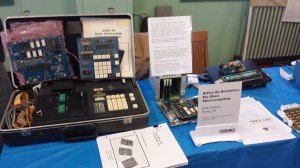
Before 8-bit computing, before the original Apple computer was displayed at the Homebrew Computer Club, there were other microprocessors, like the Intel 4004, et. al.
This exhibit demonstrates some of the early microprocessors and how they are used, particularly in an industry environment. The box on the left is a PROM programmer which operates via an early microprocessor (I do not know which one) and is used to program software on PROM chips to be used in other computerized devices. The interface is similar to those microprocessor trainers they used in later decades that had the hexadecimal keypad interface. One of the demos that was running displayed alphanumeric characters on a VFD display (as seen in the upper right of the picture).
Ohio Scientific Computers
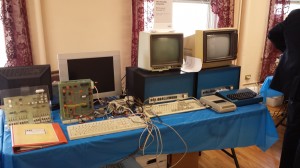
As mentioned before, these computers are generally outside my realm of interest. For one, they are large and heavy. On the other hand, they operate with a Motorola 6502 CPU, something I am rather familiar with. These systems are Ohio Scientific (OSI) Challenger computer systems. I actually own an OSI system myself, an OSI C2P OEM, which I never really hooked up and used before. But this exhibit gave me incentive to do so in the near future.
What I learned from this exhibit is that OSI systems are NOT S-100 based as I thought all along. They use a bus plane like an S-100, but it’s somewhat proprietary, hence my earlier misunderstanding. The owner of these computers was able to give me some pointers on the use of OSI systems, what to look for, how to boot them, etc.
These weren’t the only OSI systems at the show, but the others weren’t necessarily the main attractions at the other exhibits, and acted in a supporting role or were otherwise augmented with custom electronics.
Franklin Ace
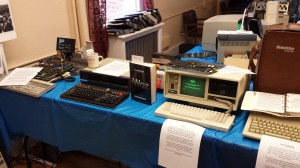
I always thought the Franklin Ace came in only one configuration. I suppose that’s one of the reasons for shows like this, to educate the public.
There were various version of the Franklin Ace line of computers. The split configuration (keyboard/CPU) design is rather interesting, especially in the luggable “Kaypro style” configuration. It would have been cool to actually own one of those. It’s a very clever design for an Apple II, considering Apple did not do any such thing themselves (at least, not that I know of).
Also on display at this exhibit was the very first Franklin Ace to come off the manufacturing line. Although I apologize for not having a picture of it.
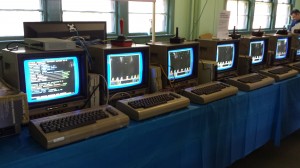
There were gaming opportunities, too, but I didn’t get a chance to play the multiplayer games on the networked series of Commodore 64 computers. On the other hand, I was impressed that they had at least eight Commodore 1702 monitors in the same room! A task that could be rather costly these days. Although, I could venture to guess there would be a fight over who had to use that sole Atari 2600 joystick. We all know how accurate and responsive THAT joystick is! (LOL) Their disk drives, however, weren’t as readily matched like the monitors. Not that it ruined their setup, but if they want all their drives to look identical too, I’m sure I’d be willing to trade them some of my 1541 drives, “even steven”, for their 1571 drives, so theirs all look the same. That sounds like a fair trade to ME!
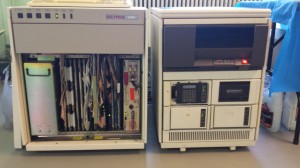
I did not get a chance to talk to the owner of this interesting computer system, so some of my information on it is rather sketchy. I stared at this particular computer system most of the time, mainly because it was sort of across the room from my exhibit. It’s called a Prime 4450.
What I found interesting about this system is that the CPU itself is comprised of more than one board. The number of cards are indicative of the system working on a backplane or bus system of connectivity.
These little “space heaters” (standing three feet high) were topped with a green screen terminal, most likely for operating system control. Beside the units, on a table, was an amber terminal displaying a text based adventure.
As for my own exhibit, I recall a lot of people milling around during the public exhibit event on both days. I had quite a few play FlappyBird on one of the TI-99s. For several hours, I really didn’t have physical access to that particular computer. I felt that I would be lynched if I even tried to shut off FlappyBird. The impact of that game on the crowd surprised me. It was a good thing to see people’s reaction to a modern game running on a vintage platform, but it still was surprising.
There were a fair amount of people who remember owning TI-99s, but not necessarily the PEBs. Therefore, questions arose from the crowd in an attempt to remember some of the subtle details. I answered them to the best of my knowledge, even answering question like why I brought TI-99s to the show. I told them that I recently finished up a project restoring full systems and was invited to bring them to VCF East to display because fully working TI-99 systems rarely end up in public view for direct interaction.
There were two visitors in particular that had an impact on me as I interacted with them. Both of them were of the younger computer generation and were younger than the TI-99 computer itself.
The first of these visitors approached the system I was using to demonstrate BBS activity. I had configured the TI-99 with a serial cable attached to a serial-to-USB adapter, to a netbook running RealTerm for Windows, which bridged the serial connection to the HeatWave BBS via telnet (heatwavebbs.com:23) via WiFi through the hotspot on my mobile phone… easy peasy, right?
I throttled the connection to 2400 baud and I found myself explaining to this person that THIS was how we communicated via computer “back in the day.” This was OUR Internet. We read text (and blocky graphics) scrolling up the screen at a measurable pace. Our world was restricted by town level regions, lest we didn’t mind long distance phone charges. Many BBSs of the day catered only to their local callers, like the I/O towers in TRON. When we sent e-mail, it was usually only to some other local member of the BBS. I explained that eventually, public protocols like FIDONet allowed BBS owners to batch up local emails and send them down the line to other BBSs for eventual retransmission around the world (and back, in several days at best). That young man was fascinated at the entire concept of BBSs of the past. It never dawned on me until then that there really IS a generation of hardcore computer users that actually don’t know the concept of a BBS. It was quite an interesting realization.
The other visitor in question was yet another one of the younger computer generation. However, this old dog (me) learned quite a bit from him. I saw him working with the speech synthesizer attached to the TI-99 and asked if he had any questions about it. Instead, I got “skooled” on it myself. He was a fountain of information about Texas Instruments semiconductors, like those used in the speech synthesizer. He rattled off various TI part numbers of speech synthesizers (made before his time), the variations of those part numbers as they pertained to the TI-99’s speech synthesizer module, and even how they were implemented in the Texas Instruments Speak & Spell. Part numbers, nomenclatures, various on-chip speech tables, etc. were all pouring out in what seemed like a non-stop dialog. Not that I minded too much, as I was learning something new here, and I was quite impressed with his knowledge of the subject. I found out that he has an interest in computer speech synthesis itself, and if his explanations to me of the concept is any indication, we could eventually find ourselves using a future software or hardware creation of his.
Early during the show, I was approached by Brad Arnold of the ANTIC podcast. It’s always good to finally meet people whose voices you hear on a regular basis. It helps put a face to the voice. He and I discussed some personal histories of the TI-99 system. Brad was there with some cohorts to promote the upcoming VCF SouthEast show. He also invited me to exhibit at VCF SouthEast in May, an opportunity that I would have liked to take advantage of, but it would be difficult to arrange on such a short notice. Although, I do encourage you all to attend that show if you can make it, if you have even the slightest interest in vintage computer technology. Also, in a completely unsolicited recommendation, try out the ANTIC Atari Podcast at ataripodcast.com.
I also got to meet a few “tech heroes” of mine. I am actually a Commodore computer aficionado. My first computer was a VIC-20, which I still have. Then I progressed to the Commodore 64, 128, and Amiga.
Well, during the first day of VCF East, I thought I saw a small group of familiar looking faces. Dave Haynie, Bil Herd, and Andy Finkel were going around the exhibits together and when they came to mine, I said in a tongue tied effort, “La-phut gabble-tog, phtttt!” Or at least, that’s what it felt like I said. But apparently, what I actually said was, “You’re the Commodore guys, aren’t you?” Afterwards, Bil said, “Hi, I’m Dave Haynie, and he’s Bil Herd (pointing to Dave)” They really are a couple of jokesters as their reputation denotes. LOL.
I asked Dave if he would sign the front bezel of my Amiga 2000. He said he would, leading up to the next awkward moment… my realization that I left that bezel IN THE CAR!!! I must thank my daughter’s quick thinking for offering to run out to the car and getting the bezel for me, because I certainly wasn’t thinking straight at the time (I owe her one). I’m surprised I didn’t wet my pants by now.
So while my daughter ran for that bezel, I “entertained the guys” by standing there like an idiot and intently listen to them explain how Commodore muscled Texas Instruments out of the market. It was a fact that I was generally aware of, but I was interesting to hear those rumors and details confirmed directly from those in the know.
When my daughter returned, Dave signed the front bezel of my Amiga 2000. I could have kicked myself for not bringing my C128 for Bil to sign. I didn’t realize he would be there! Then after Dave and Bil moved to the next exhibit, the third person in their group approached me and asked me if I wanted him to sign the bezel, too.
<AWKWARD MOMENT>
I didn’t recognize the person. I asked him his name and he said he was Andy Finkel. The name sounded familiar, but for the life of me, I just couldn’t place it. For some reason I kept thinking it was the “Andy” of Macintosh fame (Andy Hertzfeld), until he said he was in charge of software development for the Amiga line. “Ah! Now I remember!” I told him that I would love to have him sign the bezel, too. But I still feel bad that I didn’t recognize him, if not by his face, but at least by his name. Oh, the shame!!!
</AWKWARD MOMENT>
Last, but not least, I must mention the exhausting efforts of Evan Koblentz. He was the primary director of the event, and it certainly looked like his duties were keeping him busy enough. He never seemed to stop for a moment, always making sure that things were running smoothly at all times. It’s obvious that without his effort, the VCF East could have steered toward some form of chaos.

